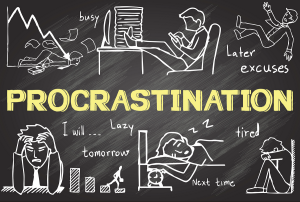Introduction
Procrastination is something that almost everyone struggles with at some point in their lives. Procrastination is when people put off or avoid tasks. This often happens because of stress, anxiety, or low motivation. While it’s a natural part of being human, procrastination can have negative effects on both our personal and professional lives, leading to missed deadlines, poor performance, and added stress. But there’s good news—science has provided us with effective strategies to beat procrastination and stay on track.
In this article, we’ll dive into science-based methods that researchers have proven to help overcome procrastination. These strategies come from psychology, neuroscience, and behavioral science. They provide practical tips to help you stop procrastinating and boost your productivity.
What is Procrastination?

Procrastination is the act of delaying or postponing tasks, often despite knowing that it will lead to negative consequences. It’s more than just poor time management; it’s a behavioral pattern linked to various psychological factors such as stress, fear of failure, and low motivation. People procrastinate for different reasons, and understanding these underlying causes is key to overcoming it.
When people procrastinate, they may feel a short sense of relief. However, this relief is often followed by guilt, shame, or anxiety about unfinished tasks. Procrastination creates a bad cycle. It makes it harder to take action and causes more stress and anxiety over time.
Procrastination can happen for several reasons:
- Avoidance of discomfort: Many people procrastinate to avoid unpleasant feelings associated with a task, such as stress or boredom.
- Perfectionism: Some individuals put off tasks because they fear that they won’t perform them perfectly.
Understanding why you procrastinate is the first step in overcoming it. Now, let’s explore some science-based strategies to help you break free from procrastination.
The Psychology Behind Procrastination
The reasons we procrastinate are deeply rooted in our psychological makeup. Here are some common psychological factors that contribute to procrastination:
- Fear of Failure: Many people avoid tasks because they fear not doing them perfectly or failing. This fear leads to avoidance behavior, which ultimately results in procrastination.
- Lack of Motivation: When a task doesn’t feel rewarding or interesting, it can be hard to find the motivation to start. This often leads to procrastination, as the brain seeks out more enjoyable activities.
- Perfectionism: Perfectionists tend to put off tasks because they feel they can’t complete them perfectly. The desire for perfection becomes a barrier to taking any action at all.
- Task Aversion: People often procrastinate on tasks they find unpleasant or overwhelming, such as paperwork or studying. This aversion leads to putting the task off indefinitely.
Science-Based Methods to Beat Procrastination

Now that we know why people procrastinate, let’s look at science-based ways to overcome this habit.
1. Break Tasks into Smaller Steps
One of the most effective ways to beat procrastination is to break large, overwhelming tasks into smaller, more manageable steps. This method, known as the “chunking” technique, is grounded in cognitive psychology. Research shows that our brains can process only a limited amount of information at once. When faced with a large, complex task, it can feel overwhelming, leading to procrastination.
By breaking a task into smaller, achievable steps, the task becomes less daunting and easier to approach. For example, instead of thinking, “I need to write a 10-page report,” break it down into smaller tasks like:
- Research the topic
- Outline the report
- Write the introduction
- Write one section at a time
Each small task feels more manageable, and completing these smaller tasks provides a sense of accomplishment, which boosts motivation.
2. Use the Pomodoro Technique
The Pomodoro Technique is a time management method. It involves working in focused intervals of 25 minutes. After each interval, you take a short break. This technique is based on research about attention and focus. It uses the brain’s natural cycles of concentration and rest. The Pomodoro Technique works by creating a sense of urgency and reducing the temptation to procrastinate.
During a Pomodoro session, you focus solely on the task at hand, without distractions. After 25 minutes of work, you take a 5-minute break to rest and recharge. After completing four Pomodoros, take a longer break of 15 to 30 minutes. This approach prevents burnout and helps maintain sustained focus throughout the day.
3. Use Rewards and Punishments

Behavioral science tells us that reinforcement plays a crucial role in motivation. One of the most effective strategies for overcoming procrastination is using rewards and punishments to motivate yourself. Positive reinforcement (rewards) and negative reinforcement (punishments) can increase motivation and help you take action.
- Rewards: Reward yourself when you complete a task or reach a milestone. After finishing a hard assignment, give yourself a reward. You could watch a favorite show or enjoy a snack.
- Punishments: Conversely, set up consequences for not completing a task. For instance, if you fail to meet a deadline, you could impose a restriction, like not allowing yourself to go out with friends until the task is done.
4. Change Your Environment
Research in environmental psychology shows that our surroundings can significantly affect our behavior and productivity. If you find yourself constantly procrastinating, it may be because your environment is not conducive to focus and work. By changing your environment, you can reduce distractions and create a more productive workspace.
- Declutter your workspace: A cluttered desk can be distracting. Clear away unnecessary items and create a clean, organized space that promotes focus.
- Set up a designated workspace: Having a specific area dedicated to work can help you mentally switch into “work mode.” Avoid working from your bed or couch, as these areas are typically associated with relaxation and leisure.
A change of environment can have a significant impact on your ability to focus and reduce procrastination.
5. Address Emotional Barriers
Procrastination is often driven by negative emotions like fear, anxiety, or self-doubt. To combat this, it’s important to address the emotional barriers that contribute to procrastination. Cognitive-behavioral therapy (CBT) offers strategies to help individuals reframe negative thoughts and overcome emotional blocks.
- Challenge negative thoughts: When you feel anxious or fearful about a task, ask yourself whether those thoughts are based on reality. Reframe your thinking by focusing on the positives, such as the sense of accomplishment you’ll feel once the task is completed.
- Practice self-compassion: Be kind to yourself when you make mistakes or experience setbacks. Negative self-talk can increase stress and make procrastination worse, so it’s important to practice self-compassion.
6. Set Clear Deadlines and Goals
Setting clear deadlines and goals is a powerful way to combat procrastination. When you set specific, time-bound goals, you create a sense of urgency that motivates you to take action. Research in goal-setting theory shows that people who set specific and measurable goals are more likely to achieve them.
- Set SMART goals: SMART goals are Specific, Measurable, Achievable, Relevant, and Time-bound. For example, instead of saying, “I want to work out more,” set a SMART goal. You could say, “I will work out for 30 minutes every Monday, Wednesday, and Friday at 7 a.m.”
- Create deadlines: Deadlines create a sense of urgency and help you stay focused. If you don’t have a deadline, tasks may feel endless, making it easier to procrastinate. Set realistic deadlines for each step of your task and stick to them.
By setting clear goals and deadlines, you’ll have a clear roadmap to follow, which reduces procrastination and keeps you on track.
Conclusion
Procrastination can feel like an endless cycle of delay and stress, but by using science-based methods, you can break free from this habit. By applying these methods, you can boost your productivity, reduce stress, and accomplish your goals more effectively.
Call to Action:
Ready to tackle procrastination head-on? Start implementing these science-based strategies today and take control of your tasks.












